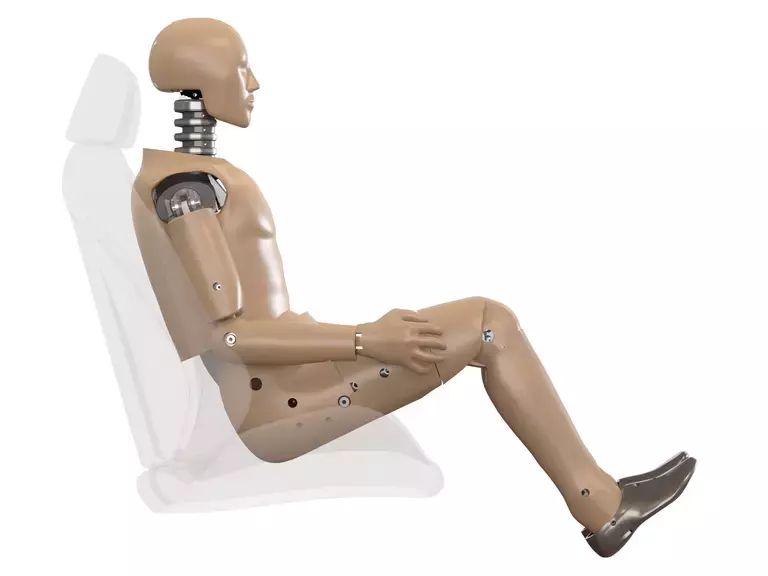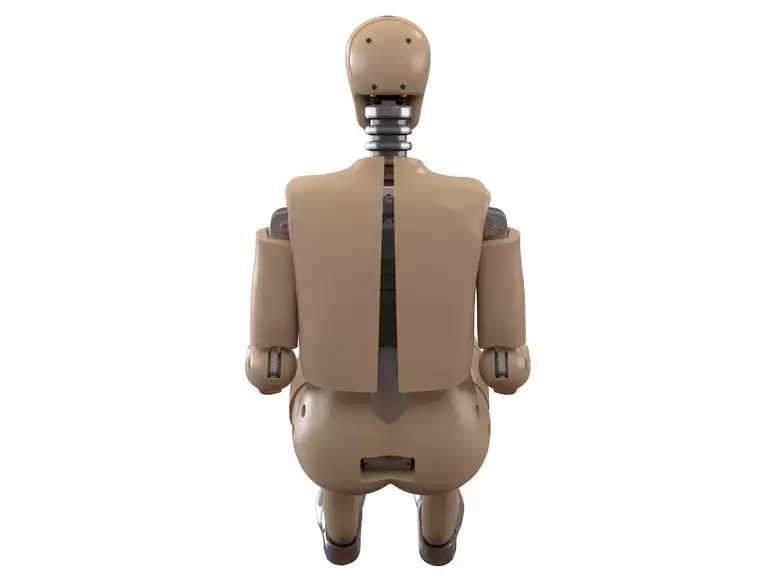




Hybrid III 50th Male
- Standard ATD 78051-218-H
- ATD with Ball Slider Knees 78051-218-BKS-H
Humanetics harmonized Hybrid III 50th Male ATD is the most widely used crash test dummy in the world for the evaluation of automotive safety restraint systems in frontal crash testing. Originally developed by General Motors, the Hybrid III 50th percentile male design is now maintained and developed by Humanetics in conjunction with the Society of Automotive Engineers' (SAE) Biomechanics Committees and the National Highway Transport and Safety Administration (NHTSA).
Our H-III 50M is a regulated test device in the USA Code of Federal Regulations (Part 572, Subpart E) and also in the European ECE Regulations. It is considered to have excellent biofidelity and instrumentation capability. Recent revisions have improved biofidelity in the femur range of motion, and also the ankle and foot. The H-III 50M dummy is also used in many non-automotive applications such as wheelchairs and medical and sports equipment.
Specifications
Key Features
Description (and comparison to the Hybrid II which it replaced).
- Improved biofidelity in the head, neck, thorax, pelvis, and knees
- Anatomically-improved head
- Neck has different flexion and extension response which is tested
- Thorax has improved biofidelic response to impact
- Lower torso uses the driver’s slouch position with a curved lumbar spine, with two spine cables for better representation of dummy posture
- Tibia displacement measurement allowed for ACL damage estimation
- Ankle bumpers minimize mechanical noise
Product Specifications
| OVERALL DIMENSIONS | 782.2 x 429.3 x 1325.9 mm | 30.8 x 16.9 x 52.2 in |
| TOTAL WEIGHT | 77.7 kg | 171.3 lb |
| FOOTPRINT/WORK AREA | 782.8 x 429.3 mm | 30.8 x 16.9 in |
| SEATED HEIGHT | 883.9 mm | 34.8 in |
Applications
- The Hybrid III 50th Male dummy is used for testing restraint systems in vehicle crash scenarios and may also be used for wheelchair testing and other modalities
- It offers consistent results and many measurement capabilities
Regulations
| WHERE USED | DEFINING REGULATION | DATES |
|---|---|---|
| EuroNCAP | EuroNCAP frontal impact testing protocol | March 2004, latest: Nov 2019 |
| Frontal Collision Protection | UNECE R94 | 16 Oct 1995; Aug 12, 1996 amended 21 Feb 2002; 31 Jan 2003; 2 Feb 2007; 13 Feb 2014; 10 June 2014, 18 June 2016 |
| Head Restraints | 49CFR Part 571.202a | 72 FR 25514, May 4, 2007, as amended at 75 FR 67246, Nov. 2, 2010; 77 FR 761, Jan. 6, 2012 |
| Hybrid III Test Dummy | 49CFR Part 572 Subpart-E | 51 FR 26701, July 25, 1986, as amended at 53 FR 8765, Mar. 17, 1988; 62 FR 27518, May 20, 1997; 63 FR 45965, Aug. 28, 1998 |
| Head Restraints | 49CFR Part 571.202a | 72 FR 25514, May 4, 2007, as amended at 75 FR 67246, Nov. 2, 2010; 77 FR 761, Jan. 6, 2012 |
| Occupant Crash Protection | 49CFR Part 571.208 |
Instrumentation
| LINEAR ACCELEROMETERS | LOAD CELLS | LOAD CELLS | LOAD CELLS | DISPLACEMENT TRANSDUCERS |
|---|---|---|---|---|
| Head Axyz, (and up to 15 accels for head rotation) | Upper Neck Fxyz, Mxyz | Lumbar Spine Fxz, My | Biaxial Knee Clevis L/R Fz, Fz | Thorax Dx |
| Thorax Axyz | Lower Neck Fxyz, Mxyz | Upper/Lower Humerus Fxy, Mxy | Upper Tibia L/R Fxz, Mxy | Tibia Displacement L/R Dx |
| Pelvis Axyz | Thoracic Rib Spine (6) Fxy, Mxy | Pelvis A.S.I.S L/R 6x Fx (with modified pelvis) | Ankle L/R Fxyz, Mxy | |
| Thoracic Spine Fxyz, Mxyz | Femur L/R Fxyz, Mxyz or Fx | Toe L/R Rz | ||
| Face L/R 5x Fx (total 10 w/special skull | Torso Flexion Stop 4 X Fx | Rib Fxy, Mxy (special spine box) | ||
| Anterior Tibia Fz | Upper Femur Fxyz, Mxyz | Lower Tibia Fxyz, Mxy |




